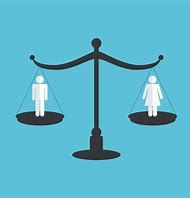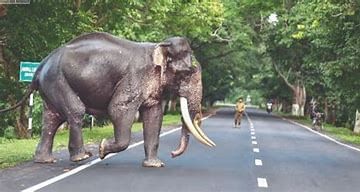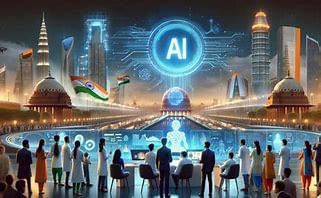UPSC Daily Current Affairs- 9th March 2024 | Current Affairs & Hindu Analysis: Daily, Weekly & Monthly PDF Download
GS-I
Chhau Dance
Subject: Art and Culture

Why in News?
As an independent art form, Chhau stands at a critical crossroad. Its easy adaptability has diluted its essential form, rising concerns about its originality.
Background:
- Chhau, the dance form, defies every label. It is too codified to be folk, too folk to be classical, and too classical and too folk to be martial.
About Chhau Dance :
- Chhau dance is a tradition from eastern India (West Bengal, Jharkhand and Odisha.) that enacts episodes from epics including the Mahabharata and Ramayana, local folklore and abstract themes.
- Its three distinct styles hail from the regions of Seraikella, Purulia and Mayurbhanj, the first two using masks.
- The Seraikella Chhau developed in Seraikela, the present day administrative headquarters of the Seraikela Kharsawan district of Jharkhand, the Purulia Chhau in Purulia district of West Bengal and the Mayurbhanj Chhau in Mayurbhanj district of Odisha.
- The Chhau dance is mainly performed during regional festivals, especially the spring festival of Chaitra Parva which lasts for thirteen days and in which the whole community participates
- Its origin is traceable to indigenous forms of dance and martial practices.
- The Chhau blends within it forms of both dance and martial practices employing mock combat techniques (called khel), stylized gaits of birds and animals (called chalis and topkas) and movements based on the chores of village housewives (called uflis)
- The dance is performed at night in an open space to traditional and folk melodies, played on the reed pipes mohuri and shehnai. The reverberating drumbeats of a variety of drums dominate the accompanying music ensemble.
- In 2010 the Chhau dance was inscribed in the UNESCO’s Representative List of the Intangible Cultural Heritage of Humanity.
Source: Scroll
GS-II
The Birth and Death (Amendment) Act of 2023
Subject: Polity and Governace

Why in News?
Recently, the Birth and Death (Amendment) Act of 2023 was passed.
Background:
- The Registration of Births and Deaths (Amendment) Act, 2023 that paves way for digital birth certificates which will be a single document to be used for admission to educational institutions, applications for driving licence, government jobs, passports or Aadhaar, voter enrolment, and registration of marriage, among others, will come into effect from October 1.
Key features of the Birth and Death (Amendment) Act of 2023:
- It adds that the Registrar General of India will maintain a national database of registered births and deaths.
- Chief Registrars and Registrars will be obligated to share data on registered births and deaths with the national database. The Chief Registrar shall maintain a similar database at the state level.
- It provides digital registration and electronic delivery of certificates of births and deaths.
- It collects the Aadhaar numbers of parents and informants in case of birth registration.
- It states that the national database may be made available to other authorities preparing or maintaining other databases like population registers, electoral rolls, ration cards, etc.
- The information will be used for purposes including admission to an educational institution, preparation of voter lists, appointment to a government post, etc.
- Any person aggrieved by any action or order of the Registrar or District Registrar may appeal to the District Registrar or Chief Registrar, respectively, within 30 days.
Concerns/Issues with the Birth and Death (Amendment) Act of 2023:
- Denying admission to school without a birth certificate may violate the fundamental right to education under Article 21A.
- Linkage across databases does not require consent from the person whose data is being linked, which is against the right to privacy.
- It does not provide alternative proof if a person does not have a birth certificate.
- It centralizes the database which may lead to mass surveillance.
Source: The Hindu
Gender Equality as the Plank of Sustainable Development
Subject: Polity and Governance

Why in News?
Conversations surrounding gender equality and women's empowerment have gained considerable momentum.
However, there is a connection between gender equality and sustainable energy development which is often overlooked.
Therefore, the issue of intricate relationship between these two domains, emphasising their fundamental role in achieving Sustainable Development Goals (SDGs) needs to be explored and discussed.
Understanding the Integral Role of Gender Equality in Sustainable Energy
- Interconnectedness with SDGs: Gender equality is tightly intertwined with the Sustainable Development Goals (SDGs), particularly SDG5 (gender equality), SDG7 (clean, affordable energy), and SDG12 (climate action).
- Cross-Cutting Influence: Gender equality serves as a foundational element that impacts the success of multiple SDGs.
- Impact on Access to Clean Energy: Numerous studies emphasize the pivotal role of gender equality and women's empowerment in attaining sustainable energy access.
- Recognition of Women in Energy: Acknowledging women as active participants in the energy sector is crucial for crafting inclusive policies and strategies for clean energy access.
- Strategic Alignment with Climate Action: Gender equality is integral to climate action, reflected in its inclusion in SDG12. Empowering women in the energy sector fosters more sustainable and climate-resilient practices.
- Social Justice and Economic Development: Gender equality in sustainable energy transcends mere SDG achievement; it represents a pursuit of social justice. Addressing gender disparities in energy access not only aligns with moral imperatives but also fuels overall economic growth and prosperity.
Gender Disparities in the Energy Sector: Reasons and Implications
- Gender Disparity in the Energy Sector: The energy industry remains notably lacking in gender diversity, with women comprising only 32% of full-time employees in renewable energy and a mere 22% in the broader energy field.
- Comparison to Global Workforce: This underrepresentation becomes stark when contrasted with the global labor force, where women make up 48% of workers.
- Educational and Training Barriers: Gender gaps in educational access and limited technical training opportunities further exacerbate the disparity, hindering women's entry into energy-related careers.
- Inequitable Workplace Policies: Discriminatory workplace practices and inadequate family-friendly policies impede women's advancement within the energy sector.
- Regional Disparities: Gender representation disparities vary across regions, influenced by factors like culture and socio-economic status. For instance, in India, only 10% of women hold technical positions in the energy sector.
- Stereotypes and Perceptions: Deep-rooted stereotypes about gender roles and abilities constrain women's access to leadership roles and technical careers within the energy industry.
- Limited Mentorship and Networking: Women in energy often struggle to access mentorship and networking opportunities, impacting their professional growth and advancement.
- Impact on Innovation and Productivity: The absence of women in the energy workforce stifles innovation and productivity. Diverse teams, including women, bring varied perspectives crucial for creative problem-solving in an industry reliant on innovation.
- Economic Ramifications: The gender gap in energy has broader economic consequences, limiting the sector's potential for growth and sustainability by excluding the valuable contributions women could make.
Economic Benefits of Empowering Women in the Energy Sector
- Economic Boost Potential: Closing the gender gap in employment and entrepreneurship within the energy sector stands to elevate global Gross Domestic Product (GDP) by trillions of dollars.
- Utilization of Women's Skills: Leveraging women's skills, expertise, and innovation could significantly drive economic growth at a global scale within the energy industry.
- Diversity Drives Innovation: Women's diverse perspectives and experiences foster innovation and creativity in the energy sector. Diverse teams, including women, are more likely to pioneer innovative solutions, leading to the advancement of new technologies and practices that enhance sector efficiency.
- Enhanced Productivity: Gender diversity correlates with increased workplace productivity. When afforded equal opportunities, women contribute to a more dynamic and productive workforce, positively impacting the performance of energy-related projects and initiatives.
- Job Creation and Inclusion: Empowering women in energy translates to job creation, promoting economic inclusion. More job opportunities for women not only improve their economic status but also contribute to poverty reduction and economic stability within society at large.
- Perception Shift and Policy Integration: Addressing gender disparity in the energy sector necessitates a shift in perceptions regarding women's roles and the integration of gender considerations into energy policies at sub-national, national, and international levels.
- Multifaceted Engagement: Governments, non-state actors, international institutions, and philanthropic organizations have crucial roles in fostering an enabling environment, offering innovative solutions, and establishing transformative platforms to bridge the gender gap in energy.
- Enhanced Access and Participation: By mainstreaming gender in energy policies, not only can access to clean energy be expanded, but groundbreaking solutions can also be developed to facilitate women's meaningful engagement in the sustainable energy transition.
- Entrepreneurship and Collaboration: Initiatives like the Energy Transitions Innovation Challenge (ENTICE) provide platforms for individuals, particularly women, to pursue entrepreneurial ventures and drive collective action for sustainable energy practices.
- Utilizing Distributed Renewable Energy (DRE): DRE initiatives, already underway in collaboration with state governments and philanthropic organizations in India, offer a swift pathway to affordable energy access, alleviating women's everyday burdens and enhancing their productivity.
- Inspiring Initiatives: Examples such as the Solar Mamas program by Barefoot College in India demonstrate the transformative potential of empowering women. Through training illiterate women to become solar engineers, such initiatives bring clean power and light to communities while empowering women economically and socially.
- It is important to recognise that the dialogue on gender and energy has clearly shifted from women being identified as part of vulnerable groups to acknowledging them as key agents of change and decision makers across the energy sector.
- Gender-responsive and women-led initiatives have been successful in the clean energy space.
- That is why, this is the right time to harness the power of women and energy to create a more inclusive, prosperous, and sustainable world for present and future generations.
GS-III
 |
Download the notes
UPSC Daily Current Affairs- 9th March 2024
|
Download as PDF |
Kerala declares man-animal conflict a state-specific disaster
Subject: Environment

Why in News?
Kerala on Wednesday (March 6) declared man-animal conflict as a state-specific disaster (as per Disaster Management Act), becoming the first state in the country to do so.
Background:-
- Kerala has been reeling under increasing count of man animal conflicts
What difference will it bring?
- At present, managing man-animal conflict is the responsibility of the forest department, which acts as per the Wild Life Protection Act.
- Once the issue is declared a state-specific disaster, the onus to deal with it shifts to the state disaster management authority, which, powered by the Disaster Management Act, can take quicker and more decisive action.
- The Chief Minister is theex officio chairman of state disaster management authority and several departments, including the forest department, are stakeholders.
- In the districts, the district disaster management authority is headed by the district collector, who is also the executive magistrate.
- Once an issue is declared a state-specific disaster or a national disaster, the disaster management authority can take quick decisions and actions overriding all other norms. Also, district collectors can directly intervene in their capacity as the chairman of the district disaster body.
- In the past, every time a life has been lost to man-animal conflict, there has been mounting chorus to tranquilise/capture/kill the animals responsible.At present, the chief wildlife warden — there is only one such post in the state — is the only authority to take a call on a wild animal wreaking havoc in human settlement. Also, in the past, there have been cases where the decision to tranquilise a killer animal, such as a wild elephant, has been questioned in court.Once the issue is under the disaster management authority, it can take actions overriding other norms, including those under the Wildlife Protection Act.
- As per section 71 of the Disaster Management Act, no court (except the Supreme Court or a High Court) shall have jurisdiction to entertain any suit or proceeding in respect of anything done by relevant authorities in pursuance of any power conferred by the Disaster Management Act. Section 72 of the Act says that the provisions of this Act will have an overriding effect on any other law during the specific period that a disaster has been declared.
- Other state-specific disasters: In 2015, Odisha had declared snakebite a state-specific disaster. In 2020, Kerala declared Covid as a state specific disaster.
Source: Indian Express
‘FY’ ALGAE
Subject: Environment

Why in News?
Recently, ‘Fy’ algae was spotted in Yellowstone National Park.
Background:
- The Yellowstone National Park, located in the western United States.It holds the distinction of being the world’s first national park, established on March 1, 1872.
About ‘FY’ ALGAE
- ‘Fy’ algae is a fungus.
- It belongs to the Fusarium strain flavlolapis family and has been trademarked as ‘Fy’.
- It has been discovered in 2009 by NASA researcher Mark Kozubal.
- ‘Fy’ algae is an extremophilic organism, meaning it can thrive under extreme conditions such as high temperatures and acidity.
- One of its remarkable traits is its ability to break down various materials and convert them into food.
- Scientists have recognized its potential as a source of packed proteins for space missions.
- This protein-packed microbe has potential use in meatless burgers, dairy substitutes, and protein powders.
- The ‘Fy’ algae can be cultured by feeding it a simple mixture of water, salts, and sugar. Ordinary metal catering trays serve as the growth medium.
- A tray of this algae reportedly contains proteins equivalent to 35 chickens.
Source: Frontiers
Fireflies
Subject: Environment

Why in News?
Researchers recently identified the key transcription factors that regulate the development of light organs and bioluminescence in the firefly.
About Fireflies:
- Fireflies, also known as lightning bugs, are beetles renowned for their ability to produce flashes of light, a phenomenon termed bioluminescence.
- There exist approximately 2,000 species of fireflies, inhabiting temperate and tropical regions across all continents except Antarctica.
Characteristics:
- They are soft-bodied beetles varying in size from 5 to 25 mm (up to 1 inch) in length.
- Fireflies utilize bioluminescence to illuminate the ends of their abdomens, employing this light to communicate with other fireflies.
- Special organs beneath their abdomens intake oxygen, which, combined with luciferin within specialized cells, generates light without significant heat production.
- Each firefly species exhibits a distinct pattern of light flashing, with males utilizing this pattern to attract conspecific females.
- Fireflies are highly efficient in bioluminescence, with nearly 100% efficiency, minimizing energy wastage in light production.
- Their lifespan spans from egg to adulthood, lasting up to a year, with most species being nocturnal, though exceptions exist with some being diurnal.
- They predominantly feed on plant pollen and nectar.
Source: Deccan Herald
IndiaAI Mission launched
Subject: Science and Technology

Why in News?
The Union Cabinet’s recent approval of the IndiaAI Mission marks a pivotal step towards harnessing artificial intelligence (AI) for national development.
- With a significant financial outlay and multifaceted objectives, this mission aims to bolster India’s AI capabilities across various sectors, fostering innovation and addressing societal challenges.
What is IndiaAI Mission?
- Establishment of a Robust AI Ecosystem: Launched under the Digital India Corporation (DIC), the IndiaAI Mission aims to create a thriving AI ecosystem that promotes innovation and facilitates growth.
- Enhancement of Computing Infrastructure: The mission focuses on bolstering computing infrastructure to support the development and deployment of AI technologies.
- Promotion of AI Applications in Critical Sectors: Initiatives within the mission target vital sectors such as healthcare and governance, aiming to integrate AI-driven solutions for enhanced efficiency and effectiveness.
- Synergistic Collaboration: Through a public-private partnership model, the mission seeks to combine governmental resources with private sector expertise. This collaborative approach ensures efficient implementation and scalability of AI initiatives, fostering sustainable growth and innovation.
Core Pillars of IndiaAI Mission
- IndiaAI Compute Capacity: Objective: Building scalable AI computing infrastructure to cater to the increasing demands of AI startups and research endeavors.
- IndiaAI Innovation Centre: Objective: Leading the development and implementation of homegrown AI models customized to meet the specific requirements of various sectors.
- IndiaAI Datasets Platform: Objective: Providing a platform to access high-quality datasets, essential for fueling AI innovation and research efforts.
- IndiaAI Application Development Initiative: Objective: Encouraging the utilization of AI solutions to tackle challenges across critical sectors through targeted application development efforts.
- IndiaAI FutureSkills: Objective: Nurturing AI talent by expanding educational programs and training initiatives across different academic levels.
- IndiaAI Startup Financing: Objective: Offering support to deep-tech AI startups via streamlined funding mechanisms to stimulate innovation.
- Safe & Trusted AI: Objective: Ensuring responsible deployment of AI technologies by developing indigenous tools and frameworks focused on safety and trustworthiness.
Strategic Significance
- National Development Agenda: The IndiaAI Mission aligns with the government’s vision of leveraging technology for inclusive growth and development.
- Global Competitiveness: By showcasing India’s prowess in AI innovation and application, the mission enhances the country’s global standing and competitiveness.
- Economic Impetus: By fostering AI-driven entrepreneurship and innovation, the mission catalyzes economic growth and job creation, leveraging India’s demographic dividend.
- Regulatory Landscape: While fostering innovation, the mission underscores the need for responsible AI governance and regulatory frameworks to address ethical and safety concerns.
Integration with National Policy
- Comprehensive Approach: The IndiaAI Mission synergizes with ongoing national initiatives, notably the Digital India campaign and endeavors to bolster electronics manufacturing.
- Strategic Alignment: The mission's emphasis on AI infrastructure and talent cultivation aligns strategically with overarching policy goals aimed at nurturing an environment conducive to technology-driven innovation.
- International Parallels: India's approach mirrors global trends, with many nations prioritizing AI development alongside the establishment of regulatory frameworks to balance innovation with considerations of safety and ethics.
Challenges and Regulatory Considerations
- Navigating Regulatory Landscape: Policymakers face the challenge of navigating intricate regulatory landscapes while promoting AI innovation, ensuring ethical deployment, and mitigating potential risks associated with AI technologies.
- Balancing Innovation and Regulation: Achieving a delicate balance between encouraging innovation and implementing regulatory measures is crucial for policymakers worldwide.
- Lessons from International Models: India can learn from international experiences and models to develop a regulatory framework that fosters innovation while maintaining ethical standards and ensuring safety in AI deployment.
Conclusion
- In conclusion, the IndiaAI Mission heralds a new era of AI-driven innovation and development in India, offering a strategic roadmap to harness the transformative potential of AI for societal benefit.
- By fostering collaboration between the public and private sectors and prioritizing talent development, this mission underscores India’s commitment to emerging as a global leader in AI innovation while navigating regulatory challenges to ensure responsible and ethical AI deployment.
Source: MSN
|
39 videos|4549 docs|972 tests
|
FAQs on UPSC Daily Current Affairs- 9th March 2024 - Current Affairs & Hindu Analysis: Daily, Weekly & Monthly
| 1. What is Chhau Dance? |  |
| 2. What is the significance of Gender Equality in the context of Sustainable Development? |  |
| 3. What is the 'FY' ALGAE mentioned in the article? |  |
| 4. How does Kerala declaring man-animal conflict a state-specific disaster affect conservation efforts? |  |
| 5. What is the objective of the IndiaAI Mission launched as mentioned in the article? |  |


























